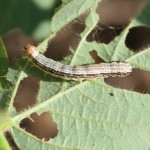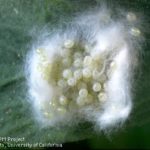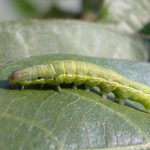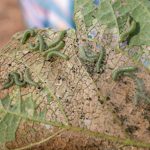I’ve had a few calls from the Mississippi River Bottom about armyworms in soybean and even in some Bt cotton. I’ve also had a few people complaining about a lack of control with insecticides and the fact that larvae were eating pigweed and then moving into the crops. This is a pretty good sign you are dealing with beet armyworm (as opposed to fall armyworm).
Fall armyworms in soybean often start on grasses, not pigweed, and move to soybean. When this occurs, they are generally easy to control with pyrethroid insecticides. Pyrethroid insecticides will not control beet armyworms. Beet armyworm may start on pigweed and survive on Bt cotton when the larvae have gained some size. In soybean, infestations may start on the soybean or originate from pigweed (or both). Control of beet armyworm requires the use of products like Belt, Besiege, Blackhawk, Intrepid, Prevathon or Radiant.
Beet armyworm can generally be distinguished from fall armyworm by a couple of characteristics. Beet armyworms hatch from an eggs mass of 20-40 eggs, and the eggs are covered with white moth scales. Freshly hatched larvae feed in a group, usually on the undersides of leaves until they are about one-third grown. The larvae are usually greenish in color, have a light head capsule, and have a small block dot on the side of their body above the second pair of true legs (see below). Shake some pigweed into your sweep net if you want to find beet armyworms.
In contrast, fall armyworm hatch from a larger egg mass (60-200 eggs) that is covered with tan-colored moth scales. The larvae spread out upon hatching, so you won’t see more than 1 or 2 feeding on the underside of a leaf. Fall armyworm larvae vary in color from brown, brownish-grey, to light green. They sometimes but not always will have a dark head capsule with the prominent inverted Y on the head capsule.
Note: In cotton or corn, fall armyworm are typically medium-brown in color with a darker head capsule. Larvae in soybean or pasture often are lighter in color, including a lighter-colored head capsule (see below). This variation often causes confusion.






